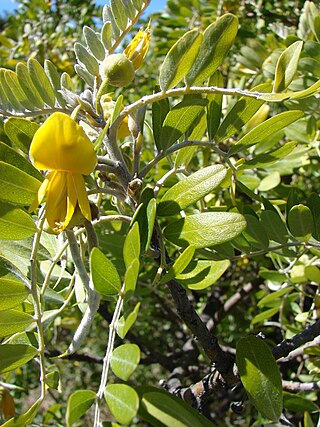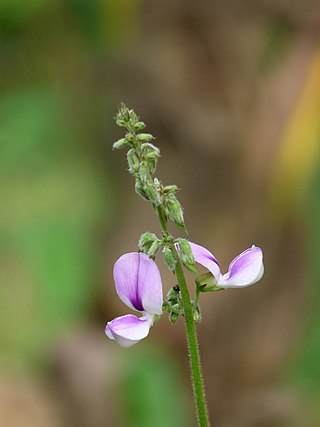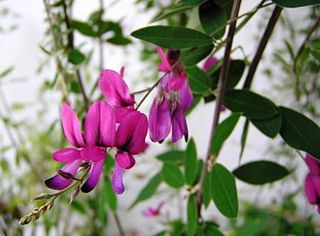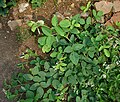
Bauhinia is a large genus of flowering plants in the subfamily Cercidoideae and tribe Bauhinieae, in the large flowering plant family Fabaceae, with a pantropical distribution. The genus was named after the Bauhin brothers Gaspard and Johann, Swiss-French botanists.

Vigna is a genus of plants in the legume family, Fabaceae, with a pantropical distribution. It includes some well-known cultivated species, including many types of beans. Some are former members of the genus Phaseolus. According to Hortus Third, Vigna differs from Phaseolus in biochemistry and pollen structure, and in details of the style and stipules.

Sophora is a genus of about 45 species of small trees and shrubs in the pea family Fabaceae. The species have a pantropical distribution. The generic name is derived from sophera, an Arabic name for a pea-flowered tree.

Pueraria is a genus of 15–20 species of legumes native to south, east, and southeast Asia and to New Guinea and northern Australia. The best known member is kudzu, also called Japanese arrowroot. The genus is named after 19th century Swiss botanist Marc Nicolas Puerari.

Lespedeza is a genus of some 45 species of flowering plants in the pea family (Fabaceae), commonly known as bush clovers or Japanese clovers (hagi). The genus is native to warm temperate to subtropical regions of eastern North America, eastern and southern Asia and Australasia.

Cissus is a genus of approximately 350 species of lianas in the grape family (Vitaceae). They have a cosmopolitan distribution, though the majority are to be found in the tropics.

Indigofera is a large genus of over 750 species of flowering plants belonging to the pea family Fabaceae. They are widely distributed throughout the tropical and subtropical regions of the world.

The plant tribe Phaseoleae is one of the subdivisions of the legume subfamily Faboideae, in the unranked NPAAA clade. This group includes many of the beans cultivated for human and animal food, most importantly from the genera Glycine, Phaseolus, and Vigna.

Campylotropis is a genus of flowering plants in the legume family, Fabaceae. It includes 41 species of shrubs native to Asia, ranging from the Himalayas to Indochina, China, Taiwan, Mongolia, and Korea, as well as Java and the Lesser Sunda Islands. Typical habitats include seasonally-dry tropical montane forests to temperate forest, woodland, and bushland. The genus belongs to subfamily Faboideae.

Christia is a genus of flowering plants in the family Fabaceae. It belongs to the subfamily Faboideae.

Dendrolobium is a genus of flowering plants in the legume family, Fabaceae. It belongs to the subfamily Faboideae. It includes 21 species of mostly trees and shrubs and rarely herbs. Species range from eastern Africa to Madagascar, India, Indochina, southern China, Malesia, Papuasia, northern and western Australia, and the southwestern Pacific. Typical habitats include seasonally-dry tropical forest and woodland, bamboo thickets, and grassland.

Flemingia is a genus of plants in the family Fabaceae. It is native sub-Saharan Africa, Yemen, tropical Asia, and Australasia. In Asia the species are distributed in Bhutan, Burma, China, India; Indonesia, Laos, Malaysia, Nepal, Pakistan, Papua New Guinea, Philippines, Sri Lanka, Taiwan, Thailand and Vietnam. The genus was erected in 1812.

Hylodesmum is a genus of flowering plants in the family Fabaceae, sometimes called ticktrefoils or tick-trefoils. It is sometimes treated as part of Desmodium. It includes 16 species native to eastern North America, sub-Saharan Africa, Yemen, south, southeast, and eastern Asia, Malesia, and New Guinea.

Phyllodium is a genus of flowering plants in the family Fabaceae, in the subfamily Faboideae, tribe Desmodieae and subtribe Desmodiinae. Species are found in tropical and subtropical Asia through to northern Australia.

The tribe Desmodieae is one of the subdivisions of the plant family Fabaceae. It is composed of two subtribes, Desmodiinae and Lespedezinae. Recent phylogenetics has this tribe nested within tribe Phaseoleae.
Pleurolobus is a genus of flowering plants in the pea family (Fabaceae). It includes six species, which range across sub-Saharan Africa, Yemen, the Indian Subcontinent, Southeast Asia, New Guinea, Micronesia, and Australia.

Grona is a genus in the flowering plant family Fabaceae. Its native range is worldwide tropics and subtropics.

Sunhangia is a genus of flowering plants in the pea family (Fabaceae). It includes six species, which range from Afghanistan through Pakistan, India, Tibet, Myanmar, and south-central and north-central China. The species in the genus were formerly placed in genus Desmodium.



















